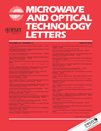High selectivity quadruple-mode broadband bandpass filter with source-load coupling
Abstract
In this letter, a high selectivity quadruple-mode broadband bandpass filter with source-load coupling is proposed using two different sizes short stub loaded stepped-impedance resonators (SIRs). Two SIRs can generate four operating modes, which can be approximately adjusted individually. Owing to the special designs of the filter, the coupling of two resonators is weak. In each resonator, the even-mode frequency can be flexibly controlled by changing the length of the short stub in central plane, whereas the odd-mode one remains stationary. Because of the source-load coupling, two transmission zeros are close to the cut-off frequencies of the passband, which leads to high selectivity. Simulated results show that central frequency is 2.27 GHz with 3-dB fractional bandwidth of 22.9%. The measured and simulated results are well complied with each other. © 2012 Wiley Periodicals, Inc. Microwave Opt Technol Lett 54:617–620, 2012; View this article online at wileyonlinelibrary.com. DOI 10.1002/mop.26668




